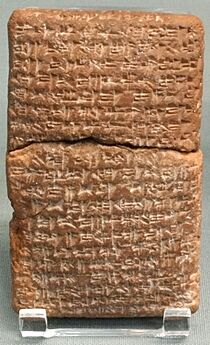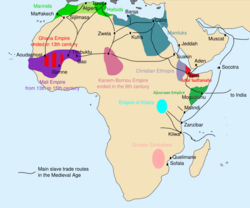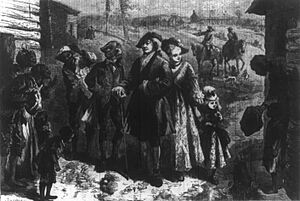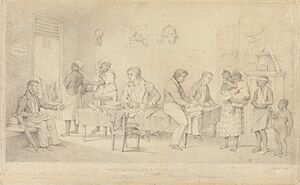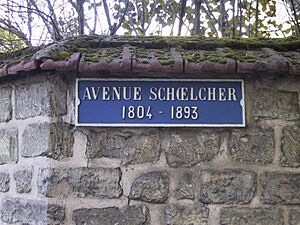History of slavery facts for kids
The history of slavery spans many cultures, nationalities, and religions from ancient times to the present day. Likewise, its victims have come from many different ethnicities and religious groups. The social, economic, and legal positions of slaves have differed vastly in different systems of slavery in different times and places.
Slavery has been found in some hunter-gatherer populations, particularly as hereditary slavery, but the conditions of agriculture with increasing social and economic complexity offer greater opportunity for mass chattel slavery. Slavery was institutionalized by the time the first civilizations emerged (such as Sumer in Mesopotamia, which dates back as far as 3500 BC). Slavery features in the Mesopotamian Code of Hammurabi (c. 1750 BC), which refers to it as an established institution. Slavery was widespread in the ancient world in Europe, Asia, the Middle East, and Africa.
It became less common throughout Europe during the Early Middle Ages, although it continued to be practised in some areas. Both Christians and Muslims captured and enslaved each other during centuries of warfare in the Mediterranean and Europe. Islamic slavery encompassed mainly Western and Central Asia, Northern and Eastern Africa, India, and Europe from the 7th to the 20th century. Islamic law approved of enslavement of non-Muslims, and slaves were trafficked from non-Muslim lands: from the North via the Balkan slave trade and the Crimean slave trade; from the East via the Bukhara slave trade; from the West via Andalusian slave trade; and from the South via the Trans-Saharan slave trade, the Red Sea slave trade and the Indian Ocean slave trade.
Beginning in the 16th century, European merchants, starting mainly with merchants from Portugal, initiated the transatlantic slave trade. Few traders ventured far inland, attempting to avoid tropical diseases and violence. They mostly purchased imprisoned Africans (and exported commodities including gold and ivory) from West African kingdoms, transporting them to Europe's colonies in the Americas. The merchants were sources of desired goods including guns, gunpowder, copper manillas, and cloth, and this demand for imported goods drove local wars and other means to the enslavement of Africans in ever greater numbers. In India and throughout the New World, people were forced into slavery to create the local workforce. The transatlantic slave trade was eventually curtailed after European and American governments passed legislation abolishing their nations' involvement in it. Practical efforts to enforce the abolition of slavery included the British Preventative Squadron and the American African Slave Trade Patrol, the abolition of slavery in the Americas, and the widespread imposition of European political control in Africa.
Prehistoric and ancient slavery
Evidence of slavery predates written records; the practice has existed in many cultures and can be traced back 11,000 years ago due to the conditions created by the invention of agriculture during the Neolithic Revolution. Economic surpluses and high population densities were conditions that made mass slavery viable.
Slavery occurred in civilizations including ancient Egypt, ancient China, the Akkadian Empire, Assyria, Babylonia, Persia, ancient Israel, ancient Greece, ancient India, the Roman Empire, the Arab Islamic Caliphates and Sultanates, Nubia, the pre-colonial empires of Sub-Saharan Africa, and the pre-Columbian civilizations of the Americas. Ancient slavery consists of a mixture of debt-slavery, punishment for crime, prisoners of war, child abandonment, and children born to slaves.
-
Ancient Egyptian mummy soles depicting two captive foreigners, a Syrian (left) and a Nubian (right), between 332 BC and 395 c.e. (Ptolemaic or Roman period).
-
Slaves in chains during the period of Roman rule at Smyrna (present-day İzmir), 200 AD.
Ancient Greece
Records of slavery in Ancient Greece go as far back as Mycenaean Greece. The origins are not known, but it appears that slavery became an important part of the economy and society only after the establishment of cities. Slavery was common practice and an integral component of ancient Greece, as it was in other societies of the time. It is estimated that in Athens, the majority of citizens owned at least one slave. Most ancient writers considered slavery not only natural but necessary, but some isolated debate began to appear, notably in Socratic dialogues. The Stoics produced the first condemnation of slavery recorded in history.
During the 8th and the 7th centuries BC, in the course of the two Messenian Wars, the Spartans reduced an entire population to a pseudo-slavery called helotry. According to Herodotus (IX, 28–29), helots were seven times as numerous as Spartans. Following several helot revolts around the year 600 BC, the Spartans restructured their city-state along authoritarian lines, for the leaders decided that only by turning their society into an armed camp could they hope to maintain control over the numerically dominant helot population. In some Ancient Greek city-states, about 30% of the population consisted of slaves, but paid and slave labor seem to have been equally important.
Rome
Romans inherited the institution of slavery from the Greeks and the Phoenicians. As the Roman Republic expanded outward, it enslaved entire populations, thus ensuring an ample supply of laborers to work in Rome's farms, quarries and households. The people subjected to Roman slavery came from all over Europe and the Mediterranean. Slaves were used for labor, and also for amusement (e.g. gladiators). In the late Republic, the widespread use of recently enslaved groups on plantations and ranches led to slave revolts on a large scale; the Third Servile War led by Spartacus was the most famous and most threatening to Rome.
Africa
Writing in 1984, French historian Fernand Braudel noted that slavery had been endemic in Africa and part of the structure of everyday life throughout the 15th to the 18th century. "Slavery came in different guises in different societies: there were court slaves, slaves incorporated into princely armies, domestic and household slaves, slaves working on the land, in industry, as couriers and intermediaries, even as traders". During the 16th century, Europe began to outpace the Arab world in the export traffic, with its trafficking of slaves from Africa to the Americas. The Dutch imported slaves from Asia into their colony at the Cape of Good Hope (now Cape Town) in the 17th century. In 1807 Britain (which already held a small coastal territory, intended for the resettlement of formerly slaves, in Freetown, Sierra Leone) made the slave trade within its empire illegal with the Slave Trade Act 1807, and worked to extend the prohibition to other territory, as did the United States in 1808.
In Senegambia, between 1300 and 1900, close to one-third of the population was enslaved. In early Islamic states of the Western Sudan, including Ghana (750–1076), Mali (1235–1645), Segou (1712–1861), and Songhai (1275–1591), about a third of the population was enslaved. The earliest Akan state of Bonoman which had third of its population being enslaved in the 17th century. In Sierra Leone in the 19th century about half of the population consisted of slaves. In the 19th century at least half the population was enslaved among the Duala of the Cameroon, the Igbo and other peoples of the lower Niger, the Kongo, and the Kasanje kingdom and Chokwe of Angola. Among the Ashanti and Yoruba a third of the population consisted of slaves as well as Bono. The population of the Kanem was about one third enslaved. It was perhaps 40% in Bornu (1396–1893). Between 1750 and 1900 from one- to two-thirds of the entire population of the Fulani jihad states consisted of slaves. The population of the Sokoto caliphate formed by Hausas in northern Nigeria and Cameroon was half-slave in the 19th century. It is estimated that up to 90% of the population of Arab-Swahili Zanzibar was enslaved. Roughly half the population of Madagascar was enslaved.
Slavery in Ethiopia persisted until 1942. The Anti-Slavery Society estimated that there were 2,000,000 slaves in the early 1930s, out of an estimated population of between 8 and 16 million. It was finally abolished by order of emperor Haile Selassie on 26 August 1942.
When British rule was first imposed on the Sokoto Caliphate and the surrounding areas in northern Nigeria at the turn of the 20th century, approximately 2 million to 2.5 million people living there were enslaved. Slavery in northern Nigeria was finally outlawed in 1936.
-
13th century slave market in Yemen.
Americas

To participate in the slave trade in Spanish America, bankers and trading companies had to pay the Spanish king for the license, called the Asiento de Negros, but an unknown amount of the trade was illegal. After 1670 when the Spanish Empire declined substantially they outsourced part of the slave trade to the Dutch (1685–1687), the Portuguese, the French (1698–1713) and the English (1713–1750), also providing organized depots in the Caribbean islands to the Dutch, British and French America. As a result of the War of the Spanish Succession, the British government obtained the monopoly (asiento de negros) of selling African slaves in Spanish America, which was granted to the South Sea Company. Meanwhile, slave trading became a core business for privately owned enterprises in the Americas.
Among indigenous peoples
In Pre-Columbian Mesoamerica the most common forms of slavery were those of prisoners of war and debtors. People unable to pay back debts could be sentenced to work as slaves to the people owed until the debts were worked off, as a form of indentured servitude. Warfare was important to Maya society, because raids on surrounding areas provided the victims required for human sacrifice, as well as slaves for the construction of temples. Most victims of human sacrifice were prisoners of war or slaves. Slavery was not usually hereditary; children of slaves were born free. In the Inca Empire, workers were subject to a mita instead of taxes which they paid by working for the government. Each ayllu, or extended family, would decide which family member to send to do the work. It is unclear if this labor draft or corvée counts as slavery. The Spanish adopted this system, particularly for their silver mines in Bolivia.
Other slave-owning societies and tribes of the New World were, for example, the Tehuelche of Patagonia, the Comanche of Texas, the Caribs of Dominica, the Tupinambá of Brazil, the fishing societies, such as the Yurok, that lived along the west coast of North America from what is now Alaska to California, the Pawnee and Klamath. Many of the indigenous peoples of the Pacific Northwest Coast, such as the Haida and Tlingit, were traditionally known as fierce warriors and slave-traders, raiding as far as California. Slavery was hereditary, the slaves being prisoners of war. Among some Pacific Northwest tribes, about a quarter of the population was enslaved. One slave narrative was composed by an Englishman, John R. Jewitt, who had been taken alive when his ship was captured in 1802; his memoir provides a detailed look at life as a slave, and asserts that a large number were held.
British and French Caribbean
Slavery was commonly used in the parts of the Caribbean controlled by France and the British Empire. The Lesser Antilles islands of Barbados, St. Kitts, Antigua, Martinique and Guadeloupe, which were the first important societies of slaves in the Caribbean, began the widespread use of enslaved Africans by the end of the 17th century, as their economies converted from sugar production.
England had multiple sugar colonies in the Caribbean, especially Jamaica, Barbados, Nevis, and Antigua, which provided a steady flow of sugar sales; forced labor of slaves produced the sugar. By the 1700s, there were more slaves in Barbados than in all the English colonies on the mainland combined. Since Barbados did not have many mountains, English planters were able to clear land for sugarcane. Indentured servants were initially sent to Barbados to work in the sugar fields. These indentured servants were treated so poorly that future indentured servants stopped going to Barbados, and there were not enough people to work the fields. This is when the British started bringing in enslaved Africans. For the English planters in Barbados, reliance on enslaved labor was necessary for them to be able to profit from production of cane-origin sugar for the growing market for sugar in Europe and other markets.
In the Treaty of Utrecht, which ended the War of the Spanish Succession (1702–1714), the various European powers negotiating the terms of the treaty also discussed colonial issues as well. Of special importance in the negotiations at Utrecht was the successful negotiation between the British and French delegations for Britain to obtain a thirty-year monopoly on the right to sell slaves in Spanish America, called the Asiento de Negros. Queen Anne also allowed her North American colonies like Virginia to make laws that promoted the importation of slaves. Anne had secretly negotiated with France to get its approval regarding the Asiento. In 1712, she delivered a speech which included a public announcement of her success in taking the Asiento away from France; many London merchants celebrated her economic coup. Most of the trade of slaves involved sales to Spanish colonies in the Caribbean, and to Mexico, as well as sales to European colonies in the Caribbean and in North America. Historian Vinita Ricks says the agreement allotted Queen Anne "22.5% (and King Philip V, of Spain 28%) of all profits collected for the Asiento monopoly. Ricks concludes that the Queen's "connection to slave trade revenue meant that she was no longer a neutral observer. She had a vested interest in what happened on slave ships."
By 1778, the French were importing approximately 13,000 Africans for enslavement yearly to the French West Indies.
To regularise slavery, in 1685 Louis XIV had enacted the Code Noir, a slave code accorded certain human rights to slaves and responsibilities to the master, who was obliged to feed, clothe and provide for the general well-being of his human property. Free people of color owned one-third of the plantation property and one-quarter of the slaves in Saint Domingue (later Haiti). Slavery in the First Republic was abolished on 4 February 1794. When it became clear that Napoleon intended to re-establish slavery in Saint-Domingue (Haiti), Jean-Jacques Dessalines and Alexandre Pétion switched sides, in October 1802. On 1 January 1804, Dessalines, the new leader under the dictatorial 1801 constitution, declared Haiti a free republic. Thus Haiti became the second independent nation in the Western Hemisphere, after the United States, as a result of the only successful slave rebellion in world history.
Whitehall in England announced in 1833 that slaves in British colonies would be completely freed by 1838. In the meantime, the government told slaves they had to remain on their plantations and would have the status of "apprentices" for the next six years.
In Port-of-Spain, Trinidad, on 1 August 1834, an unarmed group of mainly elderly Negroes being addressed by the Governor at Government House about the new laws, began chanting: "Pas de six ans. Point de six ans" ("Not six years. No six years"), drowning out the voice of the Governor. Peaceful protests continued until a resolution to abolish apprenticeship was passed and de facto freedom was achieved. Full emancipation for all was legally granted ahead of schedule on 1 August 1838, making Trinidad the first British colony with slaves to completely abolish slavery.
After Great Britain abolished slavery, it began to pressure other nations to do the same. France, too, abolished slavery. By then Saint-Domingue had already won its independence and formed the independent Republic of Haiti, though France still controlled Guadeloupe, Martinique and a few smaller islands.
Canada
Slavery in Canada was practised by First Nations and continued during the European colonization of Canada. It is estimated that there were 4,200 slaves in the French colony of Canada and later British North America between 1671 and 1831. Two-thirds of these were of indigenous ancestry (typically called panis) whereas the other third were of African descent. They were house servants and farm workers. The number of slaves of color increased during British rule, especially with the arrival of United Empire Loyalists after 1783. A small portion of Black Canadians today are descended from these slaves.
The practice of slavery in the Canadas ended through case law; having died out in the early 19th century through judicial actions litigated on behalf of slaves seeking manumission. The courts, to varying degrees, rendered slavery unenforceable in both Lower Canada and Nova Scotia. In Lower Canada, for example, after court decisions in the late 1790s, the "slave could not be compelled to serve longer than he would, and ... might leave his master at will." Upper Canada passed the Act Against Slavery in 1793, one of the earliest anti-slavery acts in the world. The institution was formally banned throughout most of the British Empire, including the Canadas in 1834, after the passage of the Slavery Abolition Act 1833 in the British parliament. These measures resulted in a number of Black people (free and slaves) from the United States moving to Canada after the American Revolution, known as the Black Loyalists; and again after the War of 1812, with a number of Black Refugees settling in Canada. During the mid-19th century, British North America served as a terminus for the Underground Railroad, a network of routes used by enslaved African-Americans to escape a slave state.
Latin America

During the period from the late 19th century and early 20th century, demand for the labor-intensive harvesting of rubber drove frontier expansion and slavery in Latin America and elsewhere. Indigenous peoples were enslaved as part of the rubber boom in Ecuador, Peru, Colombia, and Brazil. In Central America, rubber tappers participated in the enslavement of the indigenous Guatuso-Maleku people for domestic service.
United States
Early events
In late August 1619, the frigate White Lion, a privateer ship owned by Robert Rich, 2nd Earl of Warwick, but flying a Dutch flag arrived at Point Comfort, Virginia (several miles downstream from the colony of Jamestown, Virginia) with the first recorded slaves from Africa to Virginia. The approximately 20 Africans were from the present-day Angola. They had been removed by the White Lion's crew from a Portuguese cargo ship, the São João Bautista.
Historians are undecided if the legal practice of slavery began in the colony because at least some of them had the status of indentured servant. Alden T. Vaughn says most agree that both black slaves and indentured servants existed by 1640.
Only a small fraction of the enslaved Africans brought to the New World came to British North America, perhaps as little as 5% of the total. The vast majority of slaves were sent to the Caribbean sugar colonies, Brazil, or Spanish America.
By the 1680s, with the consolidation of England's Royal African Company, enslaved Africans were arriving in English colonies in larger numbers, and the institution continued to be protected by the British government. Colonists now began purchasing slaves in larger numbers.
Slavery in American colonial law
- 1640: Virginia courts sentence John Punch to lifetime slavery, marking the earliest legal sanctioning of slavery in English colonies.
- 1641: Massachusetts legalizes slavery.
- 1650: Connecticut legalizes slavery.
- 1652: Rhode Island bans the enslavement or forced servitude of any white or negro for more than ten years or beyond the age of 24.
- 1654: Virginia sanctions "the right of Negros to own slaves of their own race" after African Anthony Johnson, former indentured servant, sued to have fellow African John Casor declared not an indentured servant but "slave for life."
- 1661: Virginia officially recognizes slavery by statute.
- 1662: A Virginia statute declares that children born would have the same status as their mother.
- 1663: Maryland legalizes slavery.
- 1664: Slavery is legalized in New York and New Jersey.
- 1670: Carolina (later, South Carolina and North Carolina) is founded mainly by planters from the overpopulated British sugar island colony of Barbados, who brought relatively large numbers of African slaves from that island.
- 1676: Rhode Island bans the enslavement of Native Americans.
Development of slavery
The shift from indentured servants to enslaved African was prompted by a dwindling class of former servants who had worked through the terms of their indentures and thus became competitors to their former masters. These newly freed servants were rarely able to support themselves comfortably, and the tobacco industry was increasingly dominated by large planters. This caused domestic unrest culminating in Bacon's Rebellion. Eventually, chattel slavery became the norm in regions dominated by plantations.
The Fundamental Constitutions of Carolina established a model in which a rigid social hierarchy placed slaves under the absolute authority of their master. With the rise of a plantation economy in the Carolina Lowcountry based on rice cultivation, a society of slaves was created that later became the model for the King Cotton economy across the Deep South. The model created by South Carolina was driven by the emergence of a majority enslaved population that required repressive and often brutal force to control. Justification for such an enslaved society developed into a conceptual framework of white supremacy in the American colonies.
Several local slave rebellions took place during the 17th and 18th centuries: Gloucester County, Virginia Revolt (1663); New York Slave Revolt of 1712; Stono Rebellion (1739); and New York Slave Insurrection of 1741.
Early United States law
Within the British Empire, the Massachusetts courts began to follow England when, in 1772, England became the first country in the world to outlaw the slave trade within its borders (see Somerset v Stewart) followed by the Knight v. Wedderburn decision in Scotland in 1778. Between 1764 and 1774, seventeen slaves appeared in Massachusetts courts to sue their owners for freedom. In 1766, John Adams' colleague Benjamin Kent won the first trial in the present-day United States to free a slave (Slew vs. Whipple).
The Republic of Vermont allowed the enslavement of children in its constitution of 1777 suggesting that people "ought not" enslave adults, but there was no enforcement of this suggestion. Vermont entered the United States in 1791 with the same constitutional provisions. Through the Northwest Ordinance of 1787 under the Congress of the Confederation, slavery was prohibited in the territories north west of the Ohio River. In 1794, Congress banned American vessels from being used in the slave trade, and also banned the export of slaves from America to other countries. However, little effort was made to enforce this legislation. The slave ship owners of Rhode Island were able to continue in trade, and the USA's slaving fleet in 1806 was estimated to be nearly 75% as large as that of Britain, with dominance of the transportation of slaves into Cuba. By 1804, abolitionists succeeded in passing legislation that ended legal slavery in every northern state (with slaves above a certain age legally transformed to indentured servants). Congress passed an Act Prohibiting Importation of Slaves as of 1 January 1808; but not the internal slave trade.
Despite the actions of abolitionists, free blacks were subject to racial segregation in the Northern states. While the United Kingdom did not ban slavery throughout most of the empire, including British North America till 1833, free blacks found refuge in the Canadas after the American Revolutionary War and again after the War of 1812. Refugees from slavery fled the South across the Ohio River to the North via the Underground Railroad. Midwestern state governments asserted States Rights arguments to refuse federal jurisdiction over fugitives. Some juries exercised their right of jury nullification and refused to convict those indicted under the Fugitive Slave Act of 1850.
After the passage of the Kansas–Nebraska Act in 1854, armed conflict broke out in Kansas Territory, where the question of whether it would be admitted to the Union as a slave state or a free state had been left to the inhabitants. The radical abolitionist John Brown was active in the mayhem and killing in "Bleeding Kansas." The true turning point in public opinion is better fixed at the Lecompton Constitution fraud. Pro-slavery elements in Kansas had arrived first from Missouri and quickly organized a territorial government that excluded abolitionists. Through the machinery of the territory and violence, the pro-slavery faction attempted to force the unpopular pro-slavery Lecompton Constitution through the state. This infuriated Northern Democrats, who supported popular sovereignty, and was exacerbated by the Buchanan administration reneging on a promise to submit the constitution to a referendum—which would surely fail. Anti-slavery legislators took office under the banner of the newly formed Republican Party. The Supreme Court in the Dred Scott decision of 1857 asserted that one could take one's property anywhere, even if one's property was chattel and one crossed into a free territory. It also asserted that African Americans could not be federal citizens. Outraged critics across the North denounced these episodes as the latest of the Slave Power (the politically organized slave owners) taking more control of the nation.
American Civil War
The enslaved population in the United States stood at four million. Ninety-five percent of blacks lived in the South, constituting one third of the population there as opposed to 1% of the population of the North. The central issue in politics in the 1850s involved the extension of slavery into the western territories, which settlers from the Northern states opposed. The Whig Party split and collapsed on the slavery issue, to be replaced in the North by the new Republican Party, which was dedicated to stopping the expansion of slavery. Republicans gained a majority in every northern state by absorbing a faction of anti-slavery Democrats, and warning that slavery was a backward system that undercut liberal democracy and economic modernization. Numerous compromise proposals were put forward, but they all collapsed. A majority of Northern voters were committed to stopping the expansion of slavery, which they believed would ultimately end slavery. Southern voters were overwhelmingly angry that they were being treated as second-class citizens. In the election of 1860, the Republicans swept Abraham Lincoln into the Presidency and his party took control with legislators into the United States Congress. The states of the Deep South, convinced that the economic power of what they called "King Cotton" would overwhelm the North and win support from Europe voted to secede from the U.S. (the Union). They formed the Confederate States of America, based on the promise of maintaining slavery. War broke out in April 1861, as both sides sought wave after wave of enthusiasm among young men volunteering to form new regiments and new armies. In the North, the main goal was to preserve the union as an expression of American nationalism.
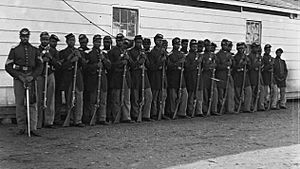
Rebel leaders Jefferson Davis, Robert E. Lee, Nathan Bedford Forrest and others were slavers and slave-traders.
By 1862 most northern leaders realized that the mainstay of Southern secession, slavery, had to be attacked head-on. All the border states rejected President Lincoln's proposal for compensated emancipation. However, by 1865 all had begun the abolition of slavery, except Kentucky and Delaware. The Emancipation Proclamation was an executive order issued by Lincoln on 1 January 1863. In a single stroke, it changed the legal status, as recognized by the U.S. government, of 3 million slaves in designated areas of the Confederacy from "slave" to "free." It had the practical effect that as soon as a slave escaped the control of the Confederate government, by running away or through advances of the Union Army, the slave became legally and actually free. Plantation owners, realizing that emancipation would destroy their economic system, sometimes moved their human property as far as possible out of reach of the Union Army. By June 1865, the Union Army controlled all of the Confederacy and liberated all of the designated slaves. The owners were never compensated. About 186,000 free blacks and newly freed people fought for the Union in the Army and Navy, thereby validating their claims to full citizenship.
The severe dislocations of war and Reconstruction had a severe negative impact on the black population, with a large amount of sickness and death. After liberation, many of the Freedmen remained on the same plantation. Others fled or crowded into refugee camps operated by the Freedmen's Bureau. The Bureau provided food, housing, clothing, medical care, church services, some schooling, legal support, and arranged for labor contracts. Fierce debates about the rights of the Freedmen, and of the defeated Confederates, often accompanied by killings of black leaders, marked the Reconstruction Era, 1863–77.
Slavery was never reestablished, but after President Ulysses S. Grant left the White House in 1877, white-supremacist "Redeemer" Southern Democrats took control of all the southern states, and blacks lost nearly all the political power they had achieved during Reconstruction. By 1900, they also lost the right to vote – they had become second class citizens. The great majority lived in the rural South in poverty working as laborers, sharecroppers or tenant farmers; a small proportion owned their own land. The black churches, especially the Baptist Church, was the center of community activity and leadership.
Abolitionist movements
Slavery has existed, in one form or another, throughout the whole of human history. So, too, have movements to free large or distinct groups of slaves. However, abolitionism should be distinguished from efforts to help a particular group of slaves, or to restrict one practice, such as the slave trade.
Drescher (2009) provides a model for the history of the abolition of slavery, emphasizing its origins in Western Europe. Around the year 1500, slavery had virtually died out in Western Europe, but was a normal phenomenon practically everywhere else. The imperial powers – the British, French, Spanish, Portuguese and Dutch empires, and a few others – built worldwide empires based primarily on plantation agriculture using slaves imported from Africa. However, the powers took care to minimize the presence of slavery in their homelands. In 1807 Britain and soon after, the United States also, both criminalized the international slave trade. The Royal Navy was increasingly effective in intercepting slave ships, freeing the captives and taking the crew for trial in courts.
Although there were numerous slave revolts in the Caribbean, the only successful uprising came in the French colony of Haiti in the 1790s, where the slaves rose up, killed the mulattoes and whites, and established the independent Republic of Haiti.
The continuing profitability of slave-based plantations and the threats of race war slowed the development of abolition movements during the first half of the 19th century. These movements were strongest in Britain, and after 1840 in the United States. The Northern states of the United States abolished slavery, partly in response to the United States Declaration of Independence, between 1777 and 1804. Britain ended slavery in its empire in the 1830s. However, the plantation economies of the southern United States, based on cotton, and those in Brazil and Cuba, based on sugar, expanded and grew even more profitable. The bloody American Civil War ended slavery in the United States in 1865. The system ended in Cuba and Brazil in the 1880s because it was no longer profitable for the owners. Slavery continued to exist in Africa, where Arab slave traders raided black areas for new captives to be sold in the system. European colonial rule and diplomatic pressure slowly put an end to the trade, and eventually to the practice of slavery itself.
Britain
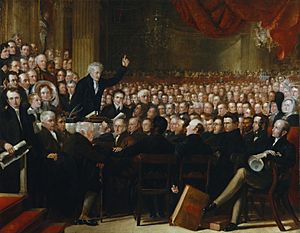
In 1772, the Somersett Case (R. v. Knowles, ex parte Somersett) of the English Court of King's Bench ruled that it was unlawful for a slave to be forcibly taken abroad. The case has since been misrepresented as finding that slavery was unlawful in England (although not elsewhere in the British Empire). A similar case, that of Joseph Knight, took place in Scotland five years later and ruled slavery to be contrary to the law of Scotland.
Following the work of campaigners in the United Kingdom, such as William Wilberforce, Henry Dundas, 1st Viscount Melville and Thomas Clarkson, who founded the Society for Effecting the Abolition of the Slave Trade (Abolition Society) in May 1787, the Act for the Abolition of the Slave Trade was passed by Parliament on 25 March 1807, coming into effect the following year. The act imposed a fine of £100 for every slave found aboard a British ship. The intention was to outlaw entirely the Atlantic slave trade within the whole British Empire.
The significance of the abolition of the British slave trade lay in the number of people hitherto sold and carried by British slave vessels. Britain shipped 2,532,300 Africans across the Atlantic, equalling 41% of the total transport of 6,132,900 individuals. This made the British empire the biggest slave-trade contributor in the world due to the magnitude of the empire, which made the abolition act all the more damaging to the global trade of slaves. Britain used its diplomatic influence to press other nations into treaties to ban their slave trade and to give the Royal Navy the right to interdict slave ships sailing under their national flag.
The Slavery Abolition Act, passed on 1 August 1833, outlawed slavery itself throughout the British Empire, with the exception of India. On 1 August 1834 slaves became indentured to their former owners in an apprenticeship system for six years. Full emancipation was granted ahead of schedule on 1 August 1838. Britain abolished slavery in both Hindu and Muslim India with the Indian Slavery Act, 1843.
The Society for the Mitigation and Gradual Abolition of Slavery Throughout the British Dominions (later London Anti-slavery Society ), was founded in 1823, and existed until 1838.
Domestic slavery practised by the educated African coastal elites (as well as interior traditional rulers) in Sierra Leone was abolished in 1928. A study found practices of domestic slavery still widespread in rural areas in the 1970s.
The British and Foreign Anti-Slavery Society, founded in 1839 and having gone several name changes since, still exists as Anti-Slavery International.
France
There were slaves in Metropolitan France (especially in trade ports such as Nantes or Bordeaux)., but the institution was never officially authorized there. The legal case of Jean Boucaux in 1739 clarified the unclear legal position of possible slaves in France, and was followed by laws that established registers for slaves in mainland France, who were limited to a three-year stay, for visits or learning a trade. Unregistered "slaves" in France were regarded as free. However, slavery was of vital importance to the economy of France's Caribbean possessions, especially Saint-Domingue.
Abolition
In 1793, influenced by the French Declaration of the Rights of Man and of the Citizen of August 1789 and alarmed as the massive slave revolt of August 1791 that had become the Haitian Revolution threatened to ally itself with the British, the Revolutionary French commissioners Léger-Félicité Sonthonax and Étienne Polverel declared general emancipation to reconcile them with France. In Paris, on 4 February 1794, Abbé Grégoire and the Convention ratified this action by officially abolishing slavery in all French territories outside mainland France, freeing all the slaves both for moral and security reasons.
Napoleon restores slavery
Napoleon came to power in 1799 and soon had grandiose plans for the French sugar colonies; to achieve them he reintroduced slavery. Napoleon's major adventure into the Caribbean—sending 30,000 troops in 1802 to retake Saint Domingue (Haiti) from ex-slaves under Toussaint L'Ouverture who had revolted. Napoleon wanted to preserve France's financial benefits from the colony's sugar and coffee crops; he then planned to establish a major base at New Orleans. He therefore re-established slavery in Haiti and Guadeloupe, where it had been abolished after rebellions. Slaves and black freedmen fought the French for their freedom and independence. Revolutionary ideals played a central role in the fighting for it was the slaves and their allies who were fighting for the revolutionary ideals of freedom and equality, while the French troops under General Charles Leclerc fought to restore the order of the ancien régime. The goal of re-establishing slavery explicitly contradicted the ideals of the French Revolution. The French soldiers were unable to cope with tropical diseases, and most died of yellow fever. Slavery was reimposed in Guadeloupe but not in Haiti, which became an independent black republic. Napoleon's vast colonial dreams for Egypt, India, the Caribbean Louisiana and even Australia were all doomed for lack of a fleet capable of matching Britain's Royal Navy. Realizing the fiasco Napoleon liquidated the Haiti project, brought home the survivors and sold off the huge Louisiana territory to the US in 1803.
Napoleon and slavery
In 1794 slavery was abolished in the French Empire. After seizing Lower Egypt in 1798, Napoleon Bonaparte issued a proclamation in Arabic, declaring all men to be free and equal. However, the French bought males as soldiers and females as concubines. Napoleon personally opposed the abolition and restored colonial slavery in 1802, a year after the capitulation of his troops in Egypt.
Napoleon decreed the abolition of the slave trade upon his returning from Elba in an attempt to appease Britain. His decision was confirmed by the Treaty of Paris on 20 November 1815 and by order of Louis XVIII on 8 January 1817. However, trafficking continued despite sanctions.
Victor Schœlcher and the 1848 abolition
Slavery in the French colonies was finally abolished in 1848, three months after the beginning of the revolution against the July Monarchy. It was in large part the result of the tireless 18-year campaign of Victor Schœlcher. On 3 March 1848, he had been appointed under-secretary of the navy, and caused a decree to be issued by the provisional government which acknowledged the principle of the enfranchisement of the slaves through the French possessions. He also wrote the decree of 27 April 1848 in which the French government announced that slavery was abolished in all of its colonies.
United States
In 1688, four German Quakers in Germantown presented a protest against the institution of slavery to their local Quaker Meeting. It was ignored for 150 years but in 1844 it was rediscovered and was popularized by the abolitionist movement. The 1688 Petition was the first American public document of its kind to protest slavery, and in addition was one of the first public documents to define universal human rights.
The American Colonization Society, the primary vehicle for returning black Americans to greater freedom in Africa, established the colony of Liberia in 1821–23, on the premise that former American slaves would have greater freedom and equality there. Various state colonization societies also had African colonies which were later merged with Liberia, including the Republic of Maryland, Mississippi-in-Africa, and Kentucky in Africa. These societies assisted in the movement of thousands of African Americans to Liberia, with ACS founder Henry Clay stating; "unconquerable prejudice resulting from their color, they never could amalgamate with the free whites of this country. It was desirable, therefore, as it respected them, and the residue of the population of the country, to drain them off". Abraham Lincoln, an enthusiastic supporter of Clay, adopted his position on returning the blacks to their own land.
Slaves in the United States who escaped ownership would often make their way to the Northern United States and Canada via the "Underground Railroad". The more famous of the African American abolitionists include former slaves Harriet Tubman, Sojourner Truth and Frederick Douglass. Many more people who opposed slavery and worked for abolition were northern whites, such as William Lloyd Garrison and John Brown. Slavery was legally abolished in 1865 by the Thirteenth Amendment to the United States Constitution.
While abolitionists agreed on the evils of slavery, there were differing opinions on what should happen after African Americans were freed. By the time of Emancipation, African-Americans were now native to the United States and did not want to leave. Most believed that their labor had made the land theirs as well as that of the whites.
Congress of Vienna
The Declaration of the Powers, on the Abolition of the Slave Trade, of 8 February 1815 (Which also formed ACT, No. XV. of the Final Act of the Congress of Vienna of the same year) included in its first sentence the concept of the "principles of humanity and universal morality" as justification for ending a trade that was "odious in its continuance".
Images for kids
-
A plate in the Boxer Codex possibly depicting alipin (slaves) in the pre-colonial Philippines.
-
Bombardment of Algiers by Lord Exmouth in August 1816, Thomas Luny
-
Illustration from the book: The Black Man's Lament, or, how to make sugar by Amelia Opie. (London, 1826)
See also
 In Spanish: Historia de la esclavitud para niños
In Spanish: Historia de la esclavitud para niños
- Debt bondage
- Gulag
- Indentured servitude
- Blackbirding
- Abolitionism
- Compensated emancipation
- Abolitionism in the United States
- Anti-Slavery International, founded as the British and Foreign Anti-Slavery Society in 1839
- Anti-Slavery Society (1823–1838)
- Quakers – Religious Society of Friends
- Society for Effecting the Abolition of the Slave Trade (1787–1807?)
- United States National Slavery Museum


